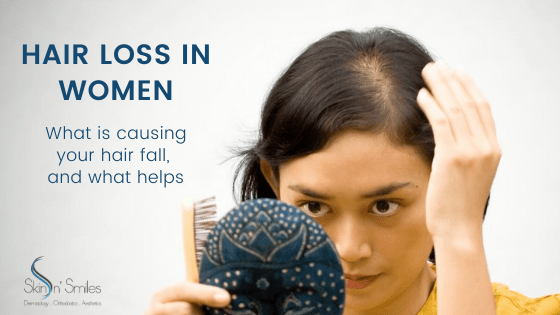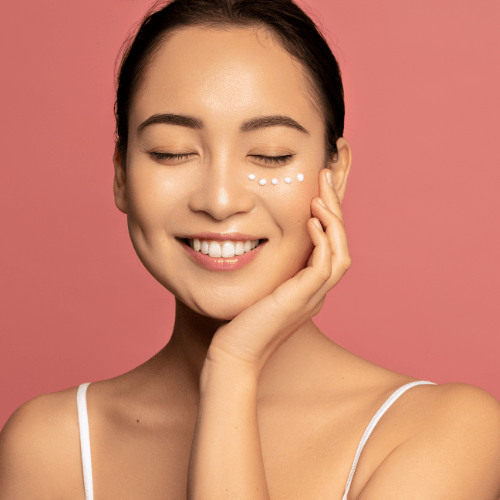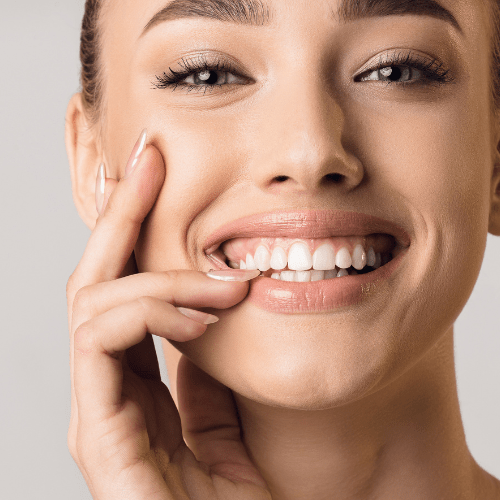Hair Loss in Women – What is causing your hair fall, and what helps
Hair Loss in Women – What is causing your hair fall, and what helps.
Hair loss can be distressing to say the least! No one want to see their beautiful locks lost to the hair brush or down the shower drain. Our doctors have seen an increase in queries from women complaining about hair loss, thinning and excessive hair fall. So, in this blog, we share some information about hair fall & thinning of hair in women – what causes it and what can help.

Your hair’s natural growth cycle
Hair grows in a cyclical process from your hair follicles – which produce and anchor the hair to the scalp. The hair growth cycle has three stages from budding new growth to shedding.
- The Anagen phase is when hair is actively growing from the roots. This phase lasts for an average of 2-7 years before hair follicles becomes dormant. The length and quality of hair growth depends on a variety of factors including your genetics, age, and overall health.
- The Catagen phase is the short transitional phase when hair stops growing and detaches itself from the blood supply.
- In the Telogen phase, the hair is shed, and the follicle enters a resting period, which can last about three months. The follicle then sprouts new hair growth.
This is a natural process, and at any given time your hair follicles are in different stages of the growth cycle. Some amount of hair fall is therefore common.
When does hair loss become problematic?
Everyone has their own pace of hair growth and loss. You might have a sense of what’s your normal. Generally, if you see 100 or more strands falling per day then it’s a matter of concern.
Hair loss should become a concern if you notice a sudden increase in the hair strands falling out, or you have clumps of hair falling out (like, say when you grab your hair, and a bunch of strands fall off in your hand). If you notice a visible thinning in your hair, it may be a sign of hormonal and other medical issues.
What could be causing your hair loss?
Hair loss in women can be a result of a variety of factors. Some external factors can be the hair products you are using, the quality of your water supply, excessive use of styling tools like dryer or hairstyles that pull on your hair too tightly. Hair loss can also be a side effect to certain medications.
Sometimes, female hair loss is caused by internal factors. It can be triggered by medical conditions like a thyroid problem, an imbalance or change in hormones, nutritional deficiencies, autoimmune conditions such as lupus, or other underlying illnesses. While less common in women, genetics can also play a role in hair loss. Female-pattern hair loss or androgenic alopecia occurs if you have inherited certain genes from one or both parents. Inflammatory conditions of the scalp, like eczema and psoriasis, are also hair loss triggers in women.
High levels of stress can also lead to hair loss. As can extreme dieting and extreme/sudden weight loss. Diet fads and trends are very common these days, and it is important that you consult a doctor before following any drastic diet plans.
Can hair loss be treated?
Yes, depending on the nature and cause of the hair loss, it can be treated! We would begin by trying to identify what’s causing the hair loss. Sometimes, it’s as simple as addressing the underlying medical condition or stopping the medication that is causing your hair to fall. For certain types of hair loss, we may also prescribe you with medications like minoxidil or nutritional supplements to boost hair regrowth.
There are also treatments available to control or minimise thinning of hair. One such novel treatment, which we have discussed previously, is plasma-rich platelet therapy (PRP Therapy) – where your own blood plasma, enriched with growth factors, is used to promote regeneration of hair follicles. Successive sessions of PRP Therapy over a period of 9 – 12 months, as advised by the doctor, can show visible improvements in hair thinning.
In some cases, you also have the option of hair transplantation treatment, which involves insertion of active follicles to the balding or thinning parts of your scalp. After the hair transplant, your hair grows back normally.
Anything I can do to prevent hair loss?
If your hair loss is caused by genetic factors, underlying illnesses, aging or a physical stressor like injury, unfortunately you cannot do anything to prevent it as such.
However, if it is a result of external factors like caustic chemicals, hair products and styling tools – simply changing up the products to something more suitable can help stop your hair loss. You can also prevent some hair loss by improving your diet, eating healthy foods including those rich in vitamins and minerals. There is never a bad reason to improve your overall health and diet habits!
When should you see a doctor?
As a general rule, whenever you notice changes in your body or health that deviate from your normal, is a good time to check in with a doctor. If you have noticed an increase in hair fall, balding patches, thinning or clumps of hair falling – come and see our Dermatologists.





